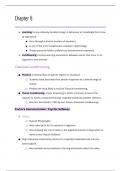Summary
Summary SLK 110 Chapter 6 notes (University of pretoria)
- Course
- Institution
- Book
The notes cover all the necessary information within Chapter 6 of the prescribed SLK/Psychology 110 textbook. The notes are able to provide the student with in-depth knowledge about the work in this chapter.
[Show more]



